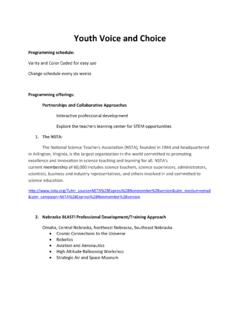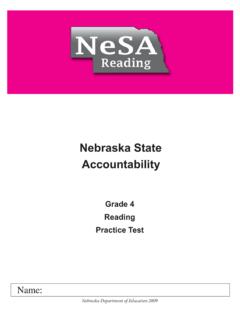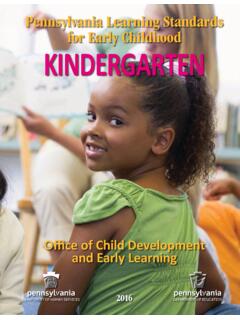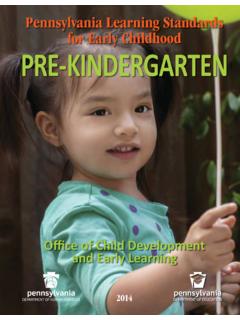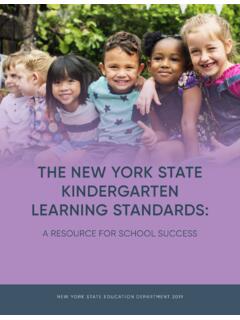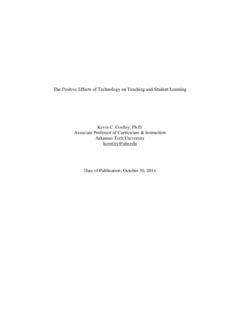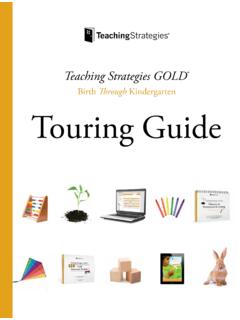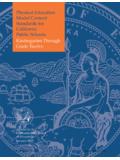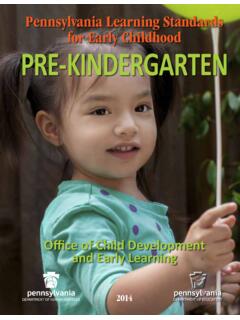Transcription of Bridging the Gaps to Improve Teaching and Learning
1 Bridging the Gaps to Improve Teaching and Learning Written by Jody C. Isernhagen, Principal Investigator, Nebraska Statewide Title I Accountability Associate Professor of Educational Administration 132 Teachers College Hall University of Nebraska-Lincoln Lincoln, NE 68588-0360 Jackie Florendo, , Doctoral Candidate Secondary Investigator, Nebraska Statewide Title I Accountability University of Nebraska-Lincoln Lincoln, NE 68588-0360 Nebraska Statewide Title I Accountability Research Project Contracted by the Nebraska Department of Education Also supported by College of Education and Human Sciences, University of Nebraska-Lincoln October, 2012 2 3 Section I: Introduction ..13 Section II: Executive Summary ..17 Section III: Research Studies ..55 Study 1: Administrator and Teacher Perceptions of the Progress of Title I Needs Improvement Schools ..55 Theme 1: Title I School Improvement Plan.
2 58 Theme 2: Clear Focus ..67 Theme 3: Culture ..81 Theme 4: Instructional Strategies ..98 Theme 5: Professional Development ..113 Theme 6: Data/Monitoring ..123 Theme 7: Community Involvement ..141 Theme 8: Overall Improvement ..150 Study 2: Educator Perceptions of Parent Involvement in Nebraska Public Schools ..185 Section IV: A. Study 1: IRB Approval Letter ..203 B. Researchers and Team Members ..207 C. Study 1: Nebraska Statewide Title I Accountability Survey ..211 D. Study 1: Nebraska Statewide Title I Accountability Interview Protocol Survey ..221 E. Study 2: IRB Approval ..229 F. Study 2: Nebraska Educator Parent Involvement Survey ..233 Bridging the Gap to Improve Teaching and Learning Table of Contents 4 TABLES Study 1: Tables 1 Administrators and Teachers Highest Mean Ratings ..21 2 Administrators and Teachers Lowest Mean 3 Title I School Improvement Plans Highest and Lowest Mean Ratings ..59 4 Clear Focus Highest and Lowest Mean Ratings.
3 67 5 Culture Highest and Lowest Mean Ratings ..81 6 Instructional Strategies Highest and Lowest Mean Ratings ..99 7 Professional Development Highest and Lowest Mean Ratings ..113 8 Data/Monitoring Highest and Lowest Mean Ratings ..124 9 Community Involvement Highest and Lowest Mean Ratings ..141 10 Overall Improvement Highest and Lowest Mean Ratings ..151 11 Significant Differences between Male and Female Administrators ..176 12 Significant Differences between Male and Female Teachers ..176 13 Significant Differences between Administrators and Teachers ..177 14 Significant Differences between Teachers with 0-10 years and 10-20 years ..177 15 Significant Differences between Teachers with 0-10 years and 20-30 years ..177 16 Significant Differences between Teachers with 10-20 years and 20-30 years ..178 17 Significant Differences between Teachers with 20-30 years and over 30 years ..179 18 Significant Differences between Free and Reduced Lunch Rates.
4 179 19 Significant Differences between Rates of ELL Student Population ..180 20 Significant Differences between Rates of Student Mobility ..181 21 Significant Differences between Elementary and Secondary verage survey rating of administrator and teacher perceptions of Title I School Improvement Plans (2011-2012). 22 and 61 5 FIGURES Study 1: Figures 1 Average survey rating of administrator and teacher perceptions of Title I School Improvement Plans (2011-2012) .. 20 and 58 Study 2: Figures 1 Positive Parental Involvement ..191 2 Indicators Impacting Student Success ..193 3 Rural and Non-Rural Schools Level of Success in Engaging Parents ..195 6 7 Terminology The following list is comprised of commonly used terms which emerged in conversations with Title I Administrators and Teachers. AdvancEd: An organization which engages in delivering high-quality school improvement and accreditation services.
5 We are committed to helping each institution celebrate its successes, yet continue to push for excellence aided by an unwavering commitment to continuous improvement. Our staff and volunteers provide leadership, technical assistance, quality assurance reviews, and communication support. Source: AIMSWeb: A web-based assessment, data management, and reporting system that provides a framework for Response to Intervention (RTI) and multi-tiered instruction. Designed specifically to universally screen and progress monitor, AIMSweb uses brief, valid, and reliable General Outcome Measures of reading and math performance for Grades K-8 that can be used with any curriculum. Source: APL: APL Associates are professional staff development associates who work to develop and refine those skills that result in a more productive in-class program but also (are) committed to setting up and assisting in maintaining a follow-up process.
6 Source: Adequate Yearly Progress (AYP): As a condition of receiving federal funds under No Child Left Behind (NCLB), all states are required to define a process for identifying groups of students, schools, districts and the State as being in need of improvement. This requirement is called adequate yearly progress or AYP. It is an annual status check of identified data elements to determine whether or not buildings and districts are meeting State AYP progress goals. Source: BrainPOP: Founded in 1999, BrainPOP creates animated, curricular content that engages students, supports educators, and bolsters achievement. In traditional, blended, and flipped Learning settings, BrainPOP supports individual, team, and whole-class Learning . At school and in informal Learning environments, our characters help introduce new topics and illustrate complex concepts. Source: California Modified Assessment (CMA): In April 2007, the United States Department of Education enacted regulations for an alternate assessment based on modified achievement standards.
7 The California Department of Education, in response to the federal regulations, is continuing to develop and implement an alternate assessment of the California content standards based on modified achievement standards for children with disabilities who have an individualized education program (IEP). Source: Check4 Learning (C4L): The Check4 Learning assessment system: blends the processes for developing, delivering, and scoring standards-based assessments, displays reports that indicate student performance, and provides feedback that supports data-driven instructional planning. Source: 8 Core Phonics: The CORE Phonics Survey assesses the phonics and phonics related skills that have a high rate of application in beginning reading. Each survey presents a number of lists of letters and words for the student to identify or decode. Pseudowords, or made-up words, are included since the student must use decoding skills to correctly pronounce these words and cannot have memorized them.
8 These assessments are best used to plan instruction for students in the primary grades and to develop instructional groups. They may be administered every four to six weeks. Source: Danielson Model: A Framework for Teaching often used for teacher evaluations, which consists of a research-based set of components of instruction, grounded in a constructivist view of Learning and Teaching . It is also referred to as Charlotte Danielson, for the Teaching and Learning expert who formulated the model. Source: DesCartes: DesCartes is a Learning continuum resource aligned to state standards. It is designed to help you translate the raw data from your students' assessments into actionable plans for instruction, grouping and more. Source: DIBELS: The Dynamic Indicators of Basic Early Literacy Skills (DIBELS) are a set of procedures and measures for assessing the acquisition of early literacy skills from kindergarten through sixth grade.
9 They are designed to be short (one minute) fluency measures used to regularly monitor the development of early literacy and early reading skills. Source: Direct Instruction: Direct Instruction (DI) is a model for Teaching that emphasizes well-developed and carefully planned lessons designed around small Learning increments and clearly defined and prescribed Teaching tasks. It is based on the theory that clear instruction eliminating misinterpretations can greatly Improve and accelerate Learning . Source: Developmental Reading Assessment (DRA): At the beginning of the school year your child will read a benchmark book to the teacher and then retell the story. The teacher then scores your child on a range of skills, such as accuracy of reading, comprehension, and fluency. This system starts with level A, for the easiest books, and then switches to numeric levels, running from 1 to 80. Source: English Language Learners (ELL): An academic program targeting students whose primary language is not English, and who are working to master the language as well as content in various areas in school.
10 Source: English Language and Literacy Assessment (ELLA): ELLA is a research-based professional development program that improves academic literacy instruction for pre-K through 8th grade students. ELLA meets the needs of English language learners, students with low-literacy skills, and other students who may experience difficulty mastering academic language. Source: #data1 9 Educational Service Unit (ESU): ESUs are service-oriented, non-regulatory agencies designed to achieve a better balance of educational opportunities for students regardless of the population, financial differences, or geographic limitations of school districts. Source: Intervention Project Manager (IPM): An individual hired to work with building principals and district administration to assist with coordinating implementation and evaluation activities, manage data and report progress to the Nebraska Department of Education to meet Title I School Improvement requirements.
